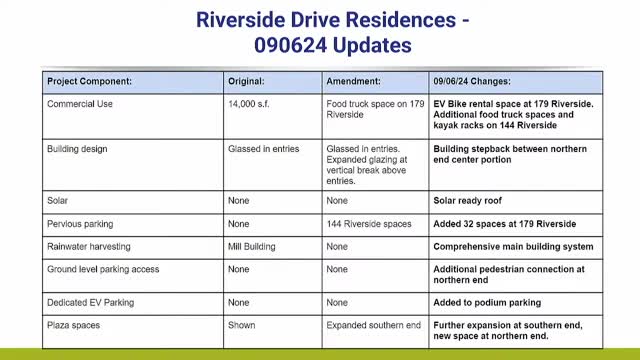City plans major upgrades to flood-prone infrastructure
September 13, 2024 | Asheville City, Buncombe County, North Carolina
This article was created by AI summarizing key points discussed. AI makes mistakes, so for full details and context, please refer to the video of the full meeting. Please report any errors so we can fix them. Report an error »

In a recent government meeting, discussions centered around significant improvements to a proposed development project, particularly focusing on infrastructure and accessibility. The Department of Energy is actively working to ensure that the necessary infrastructure can be established even in flood-prone areas, alleviating concerns about potential environmental impacts.
The project has seen a notable expansion of plaza spaces, which aims to enhance pedestrian engagement in the streetscape. This expansion has been tripled in size, with particular attention given to the southern portion of the building, where easements for overhead transmission lines are located. Additionally, a new plaza facility adjacent to a food truck area has been introduced at the northern end of the building.
The planning and zoning commission expressed confidence in the project's compliance with various comprehensive plan elements, recommending approval based on the improvements made. However, questions arose regarding the accessibility of the expanded courtyard, particularly concerning ADA compliance. While the surface areas are flat, concerns were raised about the presence of stairs leading into the building, which may not meet accessibility standards.
The discussion also touched on the use of parking pavers, a relatively new feature in commercial spaces, with inquiries about potential ADA issues. It was noted that the maintenance of these facilities would be crucial, with the building owner expected to ensure their upkeep, particularly given the involvement of residents in monitoring functionality.
The applicant confirmed that the project would maintain a commitment to 20 years of affordability, countering previous discussions that suggested a reduction to 10 years. This commitment reflects ongoing negotiations with city officials and various commissions to address community needs and feedback.
Overall, the meeting highlighted a collaborative effort between the applicant and city officials to refine the project, ensuring it meets both aesthetic and functional standards while prioritizing community engagement and accessibility.
The project has seen a notable expansion of plaza spaces, which aims to enhance pedestrian engagement in the streetscape. This expansion has been tripled in size, with particular attention given to the southern portion of the building, where easements for overhead transmission lines are located. Additionally, a new plaza facility adjacent to a food truck area has been introduced at the northern end of the building.
The planning and zoning commission expressed confidence in the project's compliance with various comprehensive plan elements, recommending approval based on the improvements made. However, questions arose regarding the accessibility of the expanded courtyard, particularly concerning ADA compliance. While the surface areas are flat, concerns were raised about the presence of stairs leading into the building, which may not meet accessibility standards.
The discussion also touched on the use of parking pavers, a relatively new feature in commercial spaces, with inquiries about potential ADA issues. It was noted that the maintenance of these facilities would be crucial, with the building owner expected to ensure their upkeep, particularly given the involvement of residents in monitoring functionality.
The applicant confirmed that the project would maintain a commitment to 20 years of affordability, countering previous discussions that suggested a reduction to 10 years. This commitment reflects ongoing negotiations with city officials and various commissions to address community needs and feedback.
Overall, the meeting highlighted a collaborative effort between the applicant and city officials to refine the project, ensuring it meets both aesthetic and functional standards while prioritizing community engagement and accessibility.
View full meeting
This article is based on a recent meeting—watch the full video and explore the complete transcript for deeper insights into the discussion.
View full meeting
